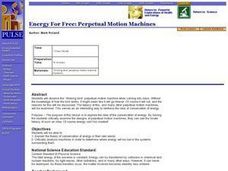Curated OER
The Probability that God Exists
In this probability activity, students are presented with how a scientist calculated the chance that God exists. References to scientists, mathematicians, and books are made.
Curated OER
Animals
Second graders discuss the term "endangered". They identify the reasons some animals are in danger of being wiped out. They discover ways humans can help the species survive.
Curated OER
Machines: Useful But Dangerous
First graders study, observe, and use a simple machine. They study necessary safety and review posted safety rules related to using a machine and identify strategies for reporting any accidents or injuries.
Curated OER
Attenuation of Light in Water
Students explore what happens to light intensity as depth increases using a light intensity logger. They construct a PVC model to hold water and identify what factors could influence the amount of light attenuation.
Curated OER
From Molecules to Mole Day Do's
Students recognize methods used to define the mole. After converting various quantities to the mole, students provide a context for understanding the usefulness of scientific notation and the mole.
Curated OER
Field of Dreams
Students study several of Marc Chagall's paintings with an emphasis on his use of symbolic color and of space. They explore learn basic techniques for using Scholar colored pencils, and create an artwork using a baseball theme.
Curated OER
Flying with Fractions
Middle schoolers test their knowledge of the Wright Brothers and their aircraft, and compute ratio of two numbers to determine the ratio between wing span and length of aircraft.
Curated OER
Understanding the Layers of the Earth
Fourth graders explore the three layers of the Earth describing the composition, thickness, and temperature of each layer. Layers are compared and contrasted and data unearthed placed into graphic organizers.
Curated OER
Exploring the Celestial Neighborhood
Ninth graders study the origin and organization of the solar system. They investigate the Earth's place in the system and how planetary motions explain natural phenomena observable from Earth.
Curated OER
Environmental Education
Second graders examine how their choices affect the environment. They identify different types of pollution and its source. They ask questions to end the lesson.
Curated OER
Causal Patterns in Density Phenomena
Students consider the causes of density at a microscopic level. They then discover that one cause of density has to do with how many protons and neutrons the material contains.
Curated OER
Energy for Free: Perpetual Motion Machines
Young scholars observe the "drinking bird" perpetual motion machine and critically examine the designs of other so-called perpetual motion machines. They use this experience to create their own definition of conservation of energy.
Curated OER
Converting Metric Units and Prefixes
Learners investigate the length of various objects. In this measurement instructional activity, students convert one metric unit to another. They explain the importance of a uniform system of measurement.
Curated OER
Where My Peeps At?
Students conduct a series of activity that demonstrates Charles' and Boyle's Law. In this chemistry lesson, students determine the relationship among pressure, volume and temperature. They solve problems using mathematical equation.
Curated OER
How Can You Study Things You Can’t See Like: Atoms?
Students simulate how scientists studied things they can't see like atoms. For this chemistry lesson, students predict what is inside the numbered obsertainers. They design a way to investigate what's inside without opening it.
Other popular searches
- Atomic Theory of Matter
- Particle Theory of Matter
- Kinetic Theory of Matter
- Particle Theory or Matter
- Particle Theory Matter
- Kinetic Theory Matter
- Molecular Theory of Matter
















